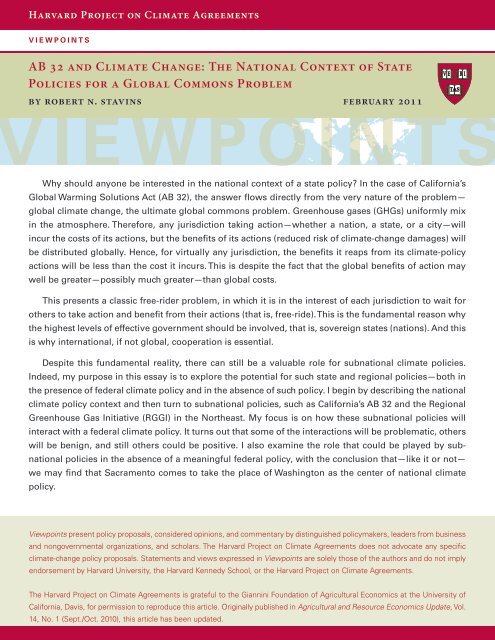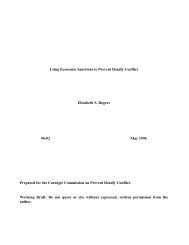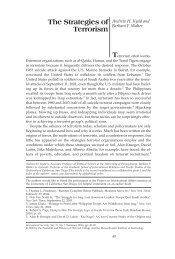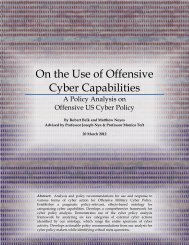AB 32 and Climate Change: The National Context of State Policies ...
AB 32 and Climate Change: The National Context of State Policies ...
AB 32 and Climate Change: The National Context of State Policies ...
You also want an ePaper? Increase the reach of your titles
YUMPU automatically turns print PDFs into web optimized ePapers that Google loves.
Harvard Project on <strong>Climate</strong> Agreementsv i e w p o i n t s<strong>AB</strong> <strong>32</strong> <strong>and</strong> <strong>Climate</strong> <strong>Change</strong>: <strong>The</strong> <strong>National</strong> <strong>Context</strong> <strong>of</strong> <strong>State</strong><strong>Policies</strong> for a Global Commons Problemby robert n. stavins february 2011i e w p o i n t sWhy should anyone be interested in the national context <strong>of</strong> a state policy? In the case <strong>of</strong> California’sGlobal Warming Solutions Act (<strong>AB</strong> <strong>32</strong>), the answer flows directly from the very nature <strong>of</strong> the problem—global climate change, the ultimate global commons problem. Greenhouse gases (GHGs) uniformly mixin the atmosphere. <strong>The</strong>refore, any jurisdiction taking action—whether a nation, a state, or a city—willincur the costs <strong>of</strong> its actions, but the benefits <strong>of</strong> its actions (reduced risk <strong>of</strong> climate-change damages) willbe distributed globally. Hence, for virtually any jurisdiction, the benefits it reaps from its climate-policyactions will be less than the cost it incurs. This is despite the fact that the global benefits <strong>of</strong> action maywell be greater—possibly much greater—than global costs.This presents a classic free-rider problem, in which it is in the interest <strong>of</strong> each jurisdiction to wait forothers to take action <strong>and</strong> benefit from their actions (that is, free-ride). This is the fundamental reason whythe highest levels <strong>of</strong> effective government should be involved, that is, sovereign states (nations). And thisis why international, if not global, cooperation is essential.Despite this fundamental reality, there can still be a valuable role for subnational climate policies.Indeed, my purpose in this essay is to explore the potential for such state <strong>and</strong> regional policies—both inthe presence <strong>of</strong> federal climate policy <strong>and</strong> in the absence <strong>of</strong> such policy. I begin by describing the nationalclimate policy context <strong>and</strong> then turn to subnational policies, such as California’s <strong>AB</strong> <strong>32</strong> <strong>and</strong> the RegionalGreenhouse Gas Initiative (RGGI) in the Northeast. My focus is on how these subnational policies willinteract with a federal climate policy. It turns out that some <strong>of</strong> the interactions will be problematic, otherswill be benign, <strong>and</strong> still others could be positive. I also examine the role that could be played by subnationalpolicies in the absence <strong>of</strong> a meaningful federal policy, with the conclusion that—like it or not—we may find that Sacramento comes to take the place <strong>of</strong> Washington as the center <strong>of</strong> national climatepolicy.Viewpoints present policy proposals, considered opinions, <strong>and</strong> commentary by distinguished policymakers, leaders from business<strong>and</strong> nongovernmental organizations, <strong>and</strong> scholars. <strong>The</strong> Harvard Project on <strong>Climate</strong> Agreements does not advocate any specificclimate-change policy proposals. <strong>State</strong>ments <strong>and</strong> views expressed in Viewpoints are solely those <strong>of</strong> the authors <strong>and</strong> do not implyendorsement by Harvard University, the Harvard Kennedy School, or the Harvard Project on <strong>Climate</strong> Agreements.<strong>The</strong> Harvard Project on <strong>Climate</strong> Agreements is grateful to the Giannini Foundation <strong>of</strong> Agricultural Economics at the University <strong>of</strong>California, Davis, for permission to reproduce this article. Originally published in Agricultural <strong>and</strong> Resource Economics Update, Vol.14, No. 1 (Sept./Oct. 2010), this article has been updated.
<strong>The</strong> (Long-Term) <strong>National</strong> <strong>Context</strong>: Carbon PricingVirtually all economists <strong>and</strong> most other policy analysts favor a national carbon-pricing policy (whethercarbon tax or cap-<strong>and</strong>-trade) as the core <strong>of</strong> any meaningful climate-policy action in the United <strong>State</strong>s.Why is this approach so overwhelmingly favored by the analytical community?First, no other feasible approach can provide truly meaningful emissions reductions (such as an 80percent cut in national CO2 emissions by mid-century). Second, it is the least costly approach in the shortterm, because abatement costs are exceptionally heterogeneous across sources. Only carbon pricingprovides strong incentives that push all sources to control at the same marginal abatement cost, therebyachieving a given aggregate target at the lowest possible cost. Third, it is the least costly approach in thelong term, because it provides incentives for carbon-friendly technological change, which brings downcosts over time. Fourth, although carbon pricing is not sufficient on its own (because <strong>of</strong> other marketfailures that reduce the impact <strong>of</strong> price signals—more about this below), it is a necessary component <strong>of</strong>a sensible climate policy, because <strong>of</strong> factors one through three, above.But carbon pricing is a hot-button political issue. This is primarily because it makes the costs <strong>of</strong> thepolicy transparent, unlike conventional policy instruments, such as performance <strong>and</strong> technology st<strong>and</strong>ards,which tend to hide costs. Carbon pricing is easily associated with the dreaded T-word. Indeed, inWashington, cap-<strong>and</strong>-trade has been successfully demonized as “cap-<strong>and</strong>-tax.” As a result, the politicalreality now appears to be that a national, economy-wide carbon-pricing policy is unlikely to be enactedbefore 2013. Does this mean that there will be no federal climate policy in the meantime? No, not at all.<strong>The</strong> (Short-Term) <strong>National</strong> <strong>Context</strong>: Federal Regulations on the Way or Already in PlaceRegulations <strong>of</strong> various kinds may soon be forthcoming—<strong>and</strong> in some cases, will definitely be forthcoming—asa result <strong>of</strong> the U.S. Supreme Court decision in Massachusetts v. EPA (April 2007) <strong>and</strong> theObama Administration’s subsequent endangerment finding (December 2009) that emissions <strong>of</strong> carbondioxide <strong>and</strong> other greenhouse gases endanger public health <strong>and</strong> welfare. This triggered mobile sourcest<strong>and</strong>ards in mid-2010, the promulgation <strong>of</strong> which identified carbon dioxide as a pollutant under the CleanAir Act, thereby initiating a process <strong>of</strong> using the Clean Air Act for stationary sources as well.Initial stationary-source st<strong>and</strong>ards took effect on January 2, 2011. <strong>The</strong> EPA plans to issue additionalnew source performance st<strong>and</strong>ards <strong>and</strong> possibly other stationary-source regulations later in 2011 <strong>and</strong> in2012.<strong>The</strong> merits that were originally suggested <strong>of</strong> such regulatory action are that it would be effective insome sectors <strong>and</strong> that the threat <strong>of</strong> such regulation will spur Congress to take action with a more sensibleapproach—namely, an economy-wide cap-<strong>and</strong>-trade system. However, regulatory action on carbondioxide under the Clean Air Act will accomplish relatively little <strong>and</strong> do so at relatively high cost, comparedwith carbon pricing. Also, Congress has now rejected cap-<strong>and</strong>-trade <strong>and</strong> will not reconsider it inthe near future. It is reasonable to ask, though, whether regulatory action was ever a credible threat; theimplementation <strong>of</strong> inflexible, high-cost regulatory approaches may lend ammunition to the staunchestopponents <strong>of</strong> any climate policy.
Air pollution policies for non–greenhouse gas pollutants, the emissions <strong>of</strong> some <strong>of</strong> which are highlycorrelated with CO 2emissions, may also play an important role. Most importantly, without any new legislation,a set <strong>of</strong> rules now making their way through the regulatory process—affecting ambient ozone, SO 2/NO 2, particulates, ash, hazardous air pollutants (mercury), <strong>and</strong> effluent water—could significantly reducethe portion <strong>of</strong> electricity generated by coal-fired power plants—including regulations affecting ambientozone, SO 2/NO 2, particulates, ash, hazardous air pollutants (mercury), <strong>and</strong> effluent water.Figure 1. Map <strong>of</strong> the RegionalGreenhouse Gas Inititative (RGGI)PartnerObserverRGGI is the first m<strong>and</strong>atory U.S. cap<strong>and</strong>-tradeprogram for carbon dioxide.It was established in December 2005by the governors <strong>of</strong> seven Northeastern<strong>and</strong> Mid-Atlantic states; three additionalstates joined in 2007, <strong>and</strong> Pennsylvaniaremains an observer.Source: www.pewclimate.org/what_s_being_done/in_the_states/rggiFinally, there is the possibility <strong>of</strong> new energy policies (nottargeted exclusively at climate change) having significant impactson CO2 emissions. <strong>The</strong> possible components <strong>of</strong> suchan approach that would be relevant in the context <strong>of</strong> climatechange include: a national renewable electricity st<strong>and</strong>ard;federal financing for clean energy projects; energy efficiencymeasures (building, appliance, <strong>and</strong> industrial efficiency st<strong>and</strong>ards;home retr<strong>of</strong>it subsidies; smart grid st<strong>and</strong>ards, subsidies,<strong>and</strong> dynamic pricing policies); <strong>and</strong> new federal electricity-transmissionsiting authority.Even without action by the Congress or by the Administration,legal action on climate policy is likely to take place withinthe judicial realm. Public nuisance litigation will no doubtcontinue, with a diverse set <strong>of</strong> lawsuits being filed across thecountry in pursuit <strong>of</strong> injunctive relief <strong>and</strong>/or damages. Due torecent court decisions, the pace, the promise, <strong>and</strong> the problems<strong>of</strong> this approach remain uncertain.Beyond the well-defined area <strong>of</strong> public nuisance litigation,other interventions which are intended to block permits fornew fossil energy investments, including both power plants<strong>and</strong> transmission lines, will continue. Some <strong>of</strong> these interventionswill be <strong>of</strong> the conventional NIMBY character, but otherswill no doubt be more strategic.But with political stalemate in Washington on carbon pricing or national climate policy, attention isinevitably turning to regional, state, <strong>and</strong> even local policies intended to address climate change.Subnational <strong>Climate</strong> <strong>Policies</strong><strong>The</strong> Regional Greenhouse Gas Initiative (RGGI) in the Northeast (Figure 1) has created a cap-<strong>and</strong>-tradesystem among electricity generators. More striking, California’s Global Warming Solutions Act (AssemblyBill <strong>32</strong>, or <strong>AB</strong> <strong>32</strong>) will likely lead to the creation <strong>of</strong> a very ambitious set <strong>of</strong> climate initiatives, including astatewide cap-<strong>and</strong>-trade system. <strong>The</strong> California system is likely to be linked with systems in other states<strong>and</strong> Canadian provinces under the Western <strong>Climate</strong> Initiative (Figure 2). Currently, more than half <strong>of</strong> the50 states are contemplating, developing, or implementing climate policies.
In the presence <strong>of</strong> a federal policy, will such state efforts achieve their objectives? Will the efforts becost-effective? <strong>The</strong> answer is that the interactions <strong>of</strong> state policies with federal policy can be problematic,benign, or positive, depending upon their relative scope <strong>and</strong> stringency, <strong>and</strong> depending upon the specificpolicy instruments used. This is the topic <strong>of</strong> a paper which Pr<strong>of</strong>essor Lawrence Goulder (Stanford University)<strong>and</strong> I have written, “Interactions Between <strong>State</strong> <strong>and</strong> Federal <strong>Climate</strong> <strong>Change</strong> <strong>Policies</strong>.” (<strong>National</strong>Bureau <strong>of</strong> Economic Research Working Paper 16123, June 2010).Figure 2. Map <strong>of</strong> the Western <strong>Climate</strong> Inititative (WCI)PartnerObserver<strong>The</strong> WCI is a collaboration <strong>of</strong> independent jurisdictions who work together to identify,evaluate, <strong>and</strong> implement policies to tackle climate change at a regional level.Other U.S. states, Canadian provinces, Mexican states, <strong>and</strong> tribes are encouragedto participate in the WCI as either partners or observers.Source: www.westernclimateinitiative.org/wci-partners-<strong>and</strong>-observers-mapProblematic InteractionsLet’s start with the case <strong>of</strong> a federal policy which limits emission quantities (as with cap-<strong>and</strong>-trade) oruses nationwide averaging <strong>of</strong> performance (as with some proposals for a national renewable portfoliost<strong>and</strong>ard). In this case, emission reductions accomplished by a “green state” with a more stringent policythan the federal policy—for example, <strong>AB</strong> <strong>32</strong> combined with Waxman-Markey/H.R. 2454—will reduce pressureon other states, thereby freeing, indeed encouraging (through lower allowance prices) emission in-
creases in the other states. <strong>The</strong> result would be 100 percent leakage, no gain in environmental protectionfrom the green state’s added activity, <strong>and</strong> a national loss <strong>of</strong> cost-effectiveness.Potential examples <strong>of</strong> this—depending upon the details <strong>of</strong> the regulations—include: first, <strong>AB</strong> <strong>32</strong> cap<strong>and</strong>-tradecombined with some U.S. Clean Air Act performance st<strong>and</strong>ards (neither H.R. 2454 nor anythinglike it are any longer on the table); second, state limits on GHGs/mile combined with federal CorporateAverage Fuel Economy (CAFE) st<strong>and</strong>ards; <strong>and</strong> third, state renewable fuels st<strong>and</strong>ards (RFS) combinedwith a federal renewable fuels st<strong>and</strong>ard or state renewable portfolio st<strong>and</strong>ards (RPS) combined with afederal RPS. A partial solution would be for these federal programs to allow states to opt out <strong>of</strong> the federalpolicy if they had an equally or more stringent state policy. Such a partial solution would not, however,be cost-effective.Benign InteractionsOne example <strong>of</strong> benign interactions <strong>of</strong> state <strong>and</strong> federal climate policy is the case <strong>of</strong> the RGGI in theNortheast. In this case, the state policies are less stringent than an assumed federal policy (such as H.R.2454). <strong>The</strong> result is that the state policies become nonbinding <strong>and</strong> hence largely irrelevant.A second example—that warms the hearts <strong>of</strong> economists, but appears to be politically irrelevant forthe time being—is the case <strong>of</strong> a federal policy that sets price, not quantity, i.e., a carbon tax or a bindingsafety valve or a price collar in a cap-<strong>and</strong>-trade system. In this case, more stringent actions in green statesdo not lead to <strong>of</strong>fsetting emissions in other states induced by a changing carbon price. It should be noted,however, that there will be different marginal abatement costs across states, <strong>and</strong> so aggregate reductionswould not be achieved cost-effectively.Positive InteractionsThree scenarios suggest the possibility <strong>of</strong> positive interactions <strong>of</strong> state <strong>and</strong> federal climate policies.First, states can—in principle—address market failures not addressed by a federal carbon-pricing policy(should there ever be one). A prime example is the principal agent problem <strong>of</strong> insufficient energy-efficiencyinvestments in renter-occupied properties, even in the face <strong>of</strong> high energy prices. This is a problem thatis best addressed at the state or even local level, such as through building codes <strong>and</strong> zoning.Second, state <strong>and</strong> regional authorities frequently argue that states can serve as valuable “laboratories”for policy design <strong>and</strong> thereby provide useful information for the development <strong>of</strong> federal policy.However, it is reasonable to ask whether state authorities will allow their “laboratory” to be closed afterthe experiment has been completed, the information delivered, <strong>and</strong> a federal policy put in place. Pronouncementsfrom some state leaders should cause concern in this regard.Third, states can create pressure for more stringent federal policies. A timely example is provided byCalifornia’s Pavley I motor vehicle fuel-efficiency st<strong>and</strong>ards <strong>and</strong> the subsequent change in federal CAFErequirements. <strong>The</strong>re is historical validation <strong>of</strong> this effect, with California repeatedly having increased thestringency <strong>of</strong> its local air pollution st<strong>and</strong>ards, followed by parallel federal action under the Clean Air Act.This linkage is desirable if the previous federal policy is insufficiently stringent, but whether that is thecase is an empirical question.
Thus, in the presence <strong>of</strong> federal climate policy, interactions with subnational policies can be problematic,benign, or positive, depending upon the relative scope <strong>and</strong> stringency <strong>of</strong> the subnational <strong>and</strong> nationalpolicies, as well as the particular policy instruments employed at both levels. (For a more rigorousderivation <strong>of</strong> the findings above, as well as an examination <strong>of</strong> a larger set <strong>of</strong> examples, please see mypaper with Lawrence Goulder, referenced below.)But comprehensive federal carbon-pricing policy appears to be delayed until 2013, at the earliest. Andit is possible that pending federal regulatory action under the Clean Air Act will be curtailed or significantlydelayed either by the new Congress or by litigation. <strong>The</strong>refore, it is important to consider the role<strong>of</strong> state <strong>and</strong> regional climate policies in the absence <strong>of</strong> federal action.Subnational <strong>Climate</strong> <strong>Policies</strong> in the Absence <strong>of</strong> Federal ActionIn brief, in the absence <strong>of</strong> meaningful federal action, subnational climate policies could well becomethe core <strong>of</strong> national action. Problems will no doubt arise, including legal obstacles such as possible federalpreemption or litigation associated with the so-called “Dormant” Commerce Clause.Also, even a large portfolio <strong>of</strong> state <strong>and</strong> regional policies will not be comprehensive <strong>of</strong> the entire nation,that is, not truly national in scope (for a quick approximation <strong>of</strong> likely coverage, check out a recentmap <strong>of</strong> blue states <strong>and</strong> red states).And even if the state <strong>and</strong> regional policies were nationally comprehensive, there would likely be differentpolicies <strong>of</strong> different stringency in different parts <strong>of</strong> the country. As a result, carbon shadow–priceswould not be equivalent, <strong>and</strong> overall policy objectives would be achieved at excessive social cost.Is there a solution (if only a partial one)? Yes. If the primary policy instrument employed in the state<strong>and</strong> regional policies is cap-<strong>and</strong>-trade, then the respective carbon markets can be linked. Such linkage occursthrough bilateral recognition <strong>of</strong> allowances, which results in reduced costs, reduced price volatility,reduced leakage, <strong>and</strong> reduced market power. Good news all around.Such bottom-up linkage <strong>of</strong> state <strong>and</strong> regional cap-<strong>and</strong>-trade systems could be an important part, orperhaps even the core, <strong>of</strong> future <strong>of</strong> U.S. climate policy, at least until there is meaningful action at thefederal level. In the meantime, it is at least conceivable—<strong>and</strong> perhaps likely—that linkage <strong>of</strong> state-levelcap-<strong>and</strong>-trade systems will become the (interim) de facto national climate policy architecture.In this way, Sacramento would take the place <strong>of</strong> Washington as the center <strong>of</strong> national climate policydeliberations <strong>and</strong> action. No doubt, this possibility will please some <strong>and</strong> frighten others.
n o t e sFor additional information, the author recommends:“Interactions Between <strong>State</strong> <strong>and</strong> Federal <strong>Climate</strong> <strong>Change</strong> <strong>Policies</strong>.” Goulder, Lawrence <strong>and</strong> RobertStavins. 2010. Cambridge, Massachusetts: <strong>National</strong> Bureau <strong>of</strong> Economic Research Working Paper16123.a u t h o r affiliationRobert N. Stavins, Albert Pratt Pr<strong>of</strong>essor <strong>of</strong> Business <strong>and</strong> Government, Harvard Kennedy Schoola b o u t t h e h a r v a r d p r o j e c t o n c l i m a t e a g r e e m e n t s<strong>The</strong> goal <strong>of</strong> the Harvard Project on <strong>Climate</strong> Agreements is to help identify <strong>and</strong> advance scientifically sound, economicallyrational, <strong>and</strong> politically pragmatic public policy options for addressing global climate change. Drawingupon leading thinkers in Australia, China, Europe, India, Japan, <strong>and</strong> the United <strong>State</strong>s, the Project conducts researchon policy architecture, key design elements, <strong>and</strong> institutional dimensions <strong>of</strong> domestic climate policy <strong>and</strong> a post-2012international climate policy regime. <strong>The</strong> Project is directed by Robert N. Stavins, Albert Pratt Pr<strong>of</strong>essor <strong>of</strong> Business<strong>and</strong> Government, John F. Kennedy School <strong>of</strong> Government, Harvard University. Major funding for the Harvard Projecton <strong>Climate</strong> Agreements is provided by a generous grant from the <strong>Climate</strong> <strong>Change</strong> Initiative <strong>of</strong> the Doris DukeCharitable Foundation.Project Email: climate@harvard.eduProject Website: http://belfercenter.ksg.harvard.edu/climate














